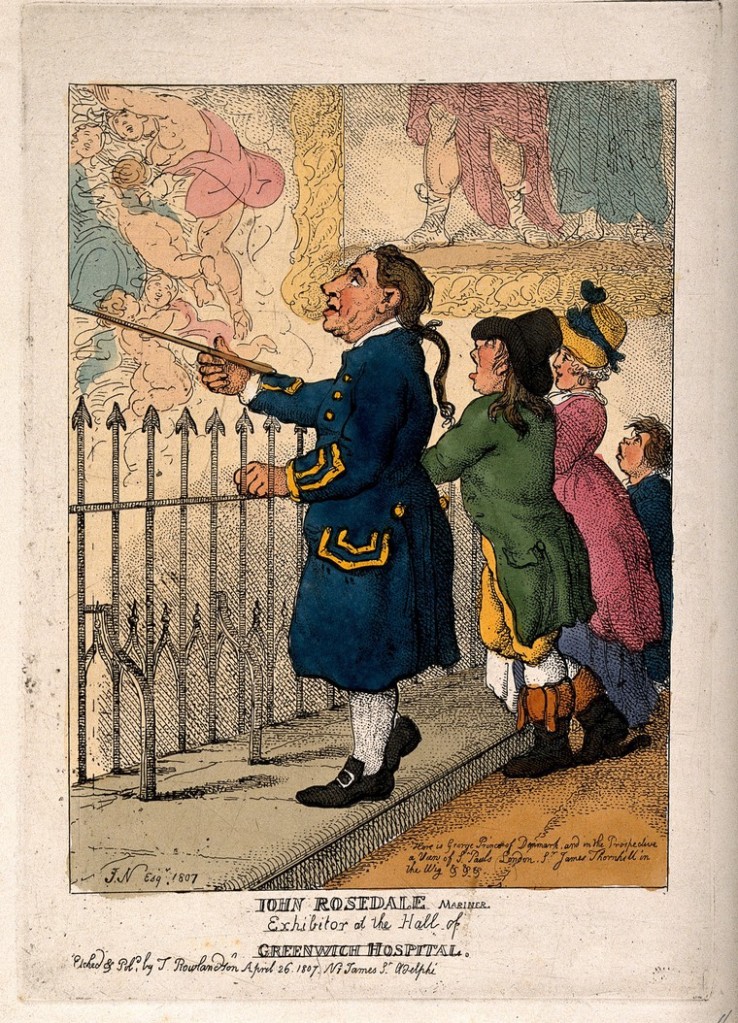#52Ancestors – “Beginnings”
Beginning the New Year with the first in a series of posts about my 4th great grandfather Benjamin Legge who had a number of new beginnings during his lifetime.
In the early autumn of 1851 Benjamin left his wife Mary and their family home in Leamington and headed to Greenwich where he was to be admitted into the care of the Royal Seamans Hospital on the banks of the River Thames.

Royal Naval Hospital, Greenwich, the river front vista, with the Queens’ House and Royal Observatory in the distance: many people walking about. Engraving by J. Newton after T. Lancey. Credit: Wellcome Collection. CC BY
The magnificent baroque building, (now known as the Old Royal Naval College and part of Maritime Greenwich World Heritage Site) designed by Sir Christopher Wren was established under the Royal Charter of William and Mary dated 25 Oct 1694 for:
“The reliefe and support of seamen serving on board the shipps or vessells belonging to the Navy Royall who by reason of Age, Wounds or other disabilities shall be uncapable of further service at sea and being unable to maintain themselves. And for the Sustentation of the Widows and the Maintenance and Education of the Children of seamen happening to be slain or disabled. Also for the further reliefe and Encouragement of seamen and Improvement of Navigation”
At the age of 73 Benjamin was presumably admitted due to old age frailty. He appeared to be fit and working at the time of the 1851 census but perhaps the competition had become too great (he was one of 18 White and Locksmiths listed in the 1850 Whites trade directory) and he found himself unable to earn enough money. He could have claimed an out-pension and remained with Mary but for reasons unknown it was decided he would become an in-pensioner while his children took care of their Mother.
On his arrival at the hospital on 19th September, Benjamin who was described in the records as being 5 feet 9 and without any wounds or injuries was issued with the hospitals traditional uniform of blue frock coat and tricorn hat.
He would also have been allocated a cabin in one of the hospitals accommodation wings and received an allowance of between one and three shillings a week.

“The Greenwich Pensioner” engraved by J.Jenkins after a picture by M.W.Sharp, publihsed in Fisher’s Drawing Room Scrap Book, 1850. Image courtesy of ancestryimages.com’

In addition to the accommodation wings, the palatial hospital buildings housed the spectacular Painted Hall where Nelson was laid in state following his death at the Battle of Trafalgar.


“Painted Hall, Royal Naval College,, Greenwich” by Christine Matthews
is licensed under CC BY-SA 2.0
As it is today the Painted Hall, described as the “UK’s Cistine Chapel” was a popular tourist attraction and Benjamin could have earned additional income by acting as a tour guide for the many visitors.

A Greenwich Pensioner showing the Thornhill decorations in the Painted Hall to a family of visitors. Coloured etching by T. Rowlandson after [J. N.] Esq, 1807. Credit: Wellcome Collection. CC BY
During his time at the hospital Benjamin would have had to follow a regimented routine and adhere to a strict code of conduct. Had he broken the rules or behaved badly he would have been disciplined. Punishments included fines, being confined to the hospital, a diet of bread and water and the dreaded “Canary” where he would have had to wear a yellow coat for a period of time.

Pensioners outside the chapel at Greenwich (‘An Old Tar doing Penance for his devotion to Jolly Bacchus’) (BHC1816). Credit National Maritime Museum, Greenwich, London.
For men only recently discharged from the navy, this regime may have been reassuring but for Benjamin who had been a civilian for over thirty years, it must have felt quite restricting.
The “Greenwich Geese” as the Pensioners were called by the locals did however have plenty of free time and were a regular sight on the streets surrounding the hospital and in the local taverns.
It was during one such outing on 3 June 1853 that Benjamin suddenly collapsed and died in Bridge Street, (now Creek Road) the main thoroughfare leading from Greenwich Market out towards Deptford.
An inquest was held to establish cause of death but as yet no records or reports have been found.
He was buried a week later, on 10 June in the hospitals’ burial ground, leaving his wife Mary, seven children and fifteen grandchildren.